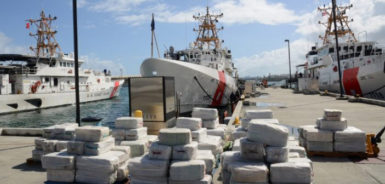Four Guyanese men who were recently intercepted in a boat in international waters with over 4 tonnes of cocaine, estimated at a street value of over US$71.7M, have since been slapped with two charges, including conspiracy to possess a controlled substance on board a vessel.
The men, Mohamed Nazim Hoseain, 64, Richard La Cruz, 49, Neville Jeffrey, 68 and Mark Anthony Williams, 30, were all charged with knowingly and intentionally conspiring to possess, with intent to distribute, more than five kilogrammes of a mixture and substance containing cocaine in violation of Title 46, United States Code.

Hoseain, who was the captain of the boat, named the Lady Michelle, La Cruz, who was the vessel’s engineer, and Jeffrey and Williams, who were crew members, were also charged with possession of a controlled substance on board a vessel, which is also in violation of Title 46, United States Code.
Among the other items found on board the vessel was US$4,000 in $100 dollar denominations.
Head of the Guyana’s Customs Anti-Narcotic Unit (CANU) James Singh told Stabroek News yesterday that the agency was working with the US Drug Enforcement Administration (DEA) to assist with investigations from this end because the men are Guyanese nationals.
However, he informed that up to yesterday it was still unclear if the men were resident in Guyana. He noted that the vessel was last in Guyana in 2013.
The four men appeared before United States Magistrate Judge George. W.Cannon on Monday in the District Court of the Virgin Islands Division of St. Croix to answer the charges and were subsequently detained.
However, they are expected to appear before the judge again today, according to court documents seen by Stabroek News.
According to DEA agent Jeremy Latchman, on February 16, while he was on routine patrol on board the U.S Coast Guard Cutter (CGC) Napier, they intercepted a suspicious vessel in a joint operation with the Trinidad & Tobago Coast Guard (TTCG) about 70 nautical miles north of Suriname in international waters.
The vessel, Lady Michelle, according to Latchman, appeared dead-in-the-water and was also in water too deep to conduct normal fishing operations. “The vessel was also located in a known drug trafficking route,” the agent said in a sworn affidavit seen by this newspaper.
Latchman said that drug traffickers commonly utilize fishing vessels to convey large quantities of drugs, which are transported from countries such as Colombia and Venezuela, where the drugs are then staged for loading onto fishing vessels and then transported through the Caribbean islands to destinations such as other islands, the US and Europe.
The blue-hulled steel fishing type vessel with the name Lady Michelle painted in white on the rear stern had four persons on board but had no visible indicia of nationality. The DEA agent said that Hoseain identified himself to the drug fighting officials, who had boarded the vessel, as the master and initially claimed that it was Guyanese flagged but later changed it to St. Vincent and the Grenadines.
The US authorities approached the Government of St. Vincent and it was confirmed that the vessel was indeed registered on that island.
Hossain informed that they were fishing but later claimed that they were in search of a missing vessel for approximately two months and while fishing gear was observed on board there was no catch.
Upon searching the vessel, the team discovered a false wooden bulkhead in the vicinity of the vessel’s fish hold, which concealed 185 bales containing numerous rectangle shaped packages, which were later tested to be drugs. The cocaine amounted to 4,100 kilogrammes.
The drugs and the crew members were transferred to CGC Vigilant and on February 25th the vessel arrived in St. Croix, U.S Virgin Islands, where the arrested men were transferred to investigating agents from the DEA St. Croix Resident Office and members of the St. Croix USCG.
The affidavit further revealed that the drugs was transported by CGC VIGILANT to San Juan, Puerto Rico and later to agents of the DEA Caribbean Division and US Customs and Border Protection (CBP).




